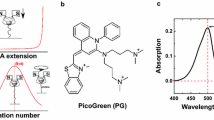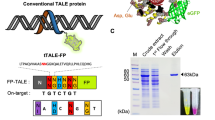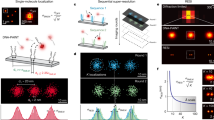Abstract
DNA intercalators are widely used in cancer therapeutics, to probe protein–DNA interactions and to investigate the statistical–mechanical properties of DNA. Here, we employ single-molecule fluorescence microscopy, magnetic tweezers, and ensemble-binding assays to investigate the fluorescence properties and binding mechanism of SYTOX green, a DNA labeling dye previously used for staining dead cells and becoming of common use for single-molecule methodologies. Specifically, we show that SYTOX green presents several advantages with respect to other dyes: (1) binds DNA rapidly and with high affinity; (2) has a good signal-to-noise ratio even at low concentrations; (3) exhibits a low photobleaching rate; and (4) induces lower light-induced DNA degradation. Finally, we show that SYTOX green is a DNA intercalator that binds DNA cooperatively with a binding site of 3.5 bp, increasing the DNA length upon binding by 43 %, while not affecting its mechanical properties.




Similar content being viewed by others
References
Akerman B, Tuite E (1996) Single- and double-strand photocleavage of DNA by YO, YOYO and TOTO. Nucleic Acids Res 24:1080–1090
Amitani I, Baskin RJ, Kowalczykowski SC (2006) Visualization of Rad54, a chromatin remodeling protein, translocating on single DNA molecules. Mol Cell 23:143–148
Baumann CG, Smith SB, Bloomfield VA, Bustamante C (1997) Ionic effects on the elasticity of single DNA molecules. Proc Natl Acad Sci USA 94:6185–6190
Bianco PR, Brewer LR, Corzett M, Balhorn R, Yeh Y, Kowalczykowski SC, Baskin RJ (2001) Processive translocation and DNA unwinding by individual RecBCD enzyme molecules. Nature 409:374–378
Blainey PC, van Oijen AM, Banerjee A, Verdine GL, Xie XS (2006) A base-excision DNA-repair protein finds intrahelical lesion bases by fast sliding in contact with DNA. Proc Natl Acad Sci USA 103:5752–5757
Bouchiat C, Wang MD, Allemand J, Strick T, Block SM, Croquette V (1999) Estimating the persistence length of a worm-like chain molecule from force-extension measurements. Biophys J 76:409–413
Bustamante C, Marko JF, Siggia ED, Smith S (1994) Entropic elasticity of lambda-phage DNA. Science 265:1599–1600
Cadet J, Douki T, Gasparutto D, Ravanat JL (2003) Oxidative damage to DNA: formation, measurement and biochemical features. Mutat Res 531:5–23
Carlsson C, Jonsson M, Akerman B (1995) Double bands in DNA gel electrophoresis caused by bis-intercalating dyes. Nucleic Acids Res 23:2413–2420
Chaires JB (2001) Analysis and interpretation of ligand-DNA binding isotherms. Methods Enzymol 340:3–22
Chaurasiya KR, Paramanathan T, McCauley MJ, Williams MC (2010) Biophysical characterization of DNA binding from single molecule force measurements. Phys Life Rev 7:299–341
Colmenarejo G, Bárcena M, Carmen Gutiérrez-Alonso M, Montero F, Orellana G (1995) DNA photocleavage by novel intercalating 6-(2-pyridinium)phenanthridinium viologens. FEBS Lett 374:426–428
Coury JE, McFail-Isom L, Williams LD, Bottomley LA (1996) A novel assay for drug-DNA binding mode, affinity, and exclusion number: scanning force microscopy. Proc Natl Acad Sci USA 93:12283–12286
Daniel E, Weber G (1966) Cooperative effects in binding by bovine serum albumin. I. The binding of 1-anilino-8-naphthalenesulfonate. Fluorim Titrations Biochem 5:1893–1900
Elmore RH, Wadkins RM, Graves DE (1988) Cooperative binding of m-AMSA to nucleic acids. Nucleic Acids Res 16:9707–9719
Günther K, Mertig M, Seidel R (2010) Mechanical and structural properties of YOYO-1 complexed DNA. Nucleic Acids Res 38:6526–6532
Gurrieri S, Wells KS, Johnson ID, Bustamante C (1997) Direct visualization of individual DNA molecules by fluorescence microscopy: characterization of the factors affecting signal/background and optimization of imaging conditions using YOYO. Anal Biochem 249:44–53
Hamdan S, Loparo J, Takahashi M, Richardson C, Van Oijen A (2009) Dynamics of DNA replication loops reveal temporal control of lagging-strand synthesis. Nature 457:336–339
Hurley LH (2002) DNA and its associated processes as targets for cancer therapy. Nat Rev Cancer 2:188–200
Kanony C, Akerman B, Tuite E (2001) Photobleaching of asymmetric cyanines used for fluorescence imaging of single DNA molecules. J Am Chem Soc 123:7985–7995
Kleimann C, Sischka A, Spiering A, Tönsing K, Sewald N, Diederichsen U, Anselmetti D (2009) Binding kinetics of bisintercalator Triostin A with optical tweezers force mechanics. Biophys J 97:2780–2784
Kowalczykowski SC, Paul LS, Lonberg N, Newport JW, McSwiggen JA, von Hippel PH (1986) Cooperative and noncooperative binding of protein ligands to nucleic acid lattices: experimental approaches to the determination of thermodynamic parameters. Biochemistry 25:1226–1240
Krisch RE, Flick MB, Trumbore CN (1991) Radiation chemical mechanisms of single- and double-strand break formation in irradiated SV40 DNA. Radiat Res 126:251–259
Kuyper CL, Brewood GP, Chiu DT (2003) Initiating conformation transitions of individual YOYO-intercalated DNA molecules with optical trapping. Nano Lett 3:1387–1389
Lerman LS (1961) Structural considerations in the interaction of DNA and acridines. J Mol Biol 3:18–30
Loparo JJ, Kulczyk AW, Richardson CC, van Oijen AM (2011) Simultaneous single-molecule measurements of phage T7 replisome composition and function reveal the mechanism of polymerase exchange. Proc Natl Acad Sci USA 108:3584–3589
Marko JF, Siggia ED (1994) Bending and twisting elasticity of DNA. Macromolecules 27:981–988
McGhee JD, von Hippel PH (1974) Theoretical aspects of DNA-protein interactions: co-operative and non-co-operative binding of large ligands to a one-dimensional homogeneous lattice. J Mol Biol 86:469–489
Murade CU, Subramaniam V, Otto C, Bennink ML (2009) Interaction of oxazole yellow dyes with DNA studied with hybrid optical tweezers and fluorescence microscopy. Biophys J 97:835–843
Nollmann M et al (2007) Multiple modes of Escherichia coli DNA gyrase activity revealed by force and torque. Nat Struct Mol Biol 14:264–271
Paik DH, Perkins TT (2012) Dynamics and multiple stable binding modes of DNA intercalators revealed by single-molecule force spectroscopy. Angew Chem Int Ed Engl 51:1811–1815
Paillous N, Vicendo P (1993) Mechanisms of photosensitized DNA cleavage. J Photochem Photobiol B Biol 20:203–209
Petty JT, Bordelon JA, Robertson ME (2000) Thermodynamic characterization of the association of cyanine dyes with DNA. J Phys Chem B 104:7221–7227
Prise KM, Folkard M, Michael BD, Vojnovic B, Brocklehurst B, Hopkirk A, Munro IH (2000) Critical energies for SSB and DSB induction in plasmid DNA by low-energy photons: action spectra for strand-break induction in plasmid DNA irradiated in vacuum Int J Rad. Biol 76:881–890
Ptacin JL, Nollmann M, Becker EC, Cozzarelli NR, Pogliano K, Bustamante C (2008) Sequence-directed DNA export guides chromosome translocation during sporulation in Bacillus subtilis. Nat Struct Mol Biol 15:485–493
Reuter M, Dryden DTF (2010) The kinetics of YOYO-1 intercalation into single molecules of double-stranded DNA. Biochem Biophys Res Commun 403:225–229
Roth BL, Poot M, Yue ST, Millard PJ (1997) Bacterial viability and antibiotic susceptibility testing with SYTOX green nucleic acid stain. Appl Environ Microbiol 63:2421–2431
Sangeetha Gowda KR, Blessy Baby M, Sudhamani CN, Bhojya Naik HS (2014) Mechanism of DNA binding and cleavage. Biomed Biotechnol 2:1–9
Shi X, Lim J, Ha T (2010) Acidification of the oxygen scavenging system in single-molecule fluorescence studies: in situ sensing with a ratiometric dual-emission probe. Anal Chem 82:6132–6138
Sischka A, Toensing K, Eckel R, Wilking SD, Sewald N, Ros R, Anselmetti D (2005) Molecular mechanisms and kinetics between DNA and DNA binding ligands. Biophys J 88:404–411
Stone MD, Bryant Z, Crisona NJ, Smith SB, Vologodskii A, Bustamante C, Cozzarelli NR (2003) Chirality sensing by Escherichia coli topoisomerase IV and the mechanism of type II topoisomerases. Proc Natl Acad Sci USA 100:8654–8659
Tanner N, Loparo J, Hamdan S, Jergic S, Dixon N, Van Oijen A (2009) Real-time single-molecule observation of rolling-circle DNA replication. Nucleic Acids Res 37:27
Trieb M, Rauch C, Wibowo FR, Wellenzohn B, Liedl KR (2004) Cooperative effects on the formation of intercalation sites. Nucleic Acids Res 32:4696–4703
Tycon MA, Dial CF, Faison K, Melvin W, Fecko CJ (2012) Quantification of dye-mediated photodamage during single-molecule DNA imaging. Anal Biochem 426:13–21
van Mameren J, Peterman EJ, Wuite GJ (2008) See me, feel me: methods to concurrently visualize and manipulate single DNA molecules and associated proteins. Nucleic Acids Res 36:4381–4389
Vladescu ID, McCauley MJ, Nunez ME, Rouzina I, Williams MC (2007) Quantifying force-dependent and zero-force DNA intercalation by single-molecule stretching. Nat Methods 4:517–522
Yan X, Habbersett RC, Cordek JM, Nolan JP, Yoshida TM, Jett JH, Marrone BL (2000) Development of a mechanism-based, DNA staining protocol using SYTOX orange nucleic acid stain and DNA fragment sizing flow cytometry. Anal Biochem 286:138–148
Yu H-J et al (2009) Synthesis, DNA-binding and photocleavage studies of ruthenium complexes [Ru(bpy)2(mitatp)]2+ and [Ru(bpy)2(nitatp)]2+. J Inorg Biochem 103:881–890
Acknowledgments
We acknowledge Catherine Royer for critical reading of the manuscript and Stephanie Dejardin for the preparation of DNA substrates. Fluorescence anisotropy and TIRF experiments were performed at the Biophysics facility of the Centre de Biochimie Structurale (CBS) funded by the Plate-forme Intégrée de Biologie Structurale (IBISA) and the France-BioImaging infrastructure supported by the French National Research Agency (ANR-10-INSB-04, “Investments for the future”). This work was supported by the Agence Nationale de la Recherche (ANR-2010-BLAN-1525-01, and ANR-2010-BLAN-1221-01), and the Human Frontiers Science Program through a Career Development Award (M.N.).
Author information
Authors and Affiliations
Corresponding author
Electronic supplementary material
Below is the link to the electronic supplementary material.
Rights and permissions
About this article
Cite this article
Thakur, S., Cattoni, D.I. & Nöllmann, M. The fluorescence properties and binding mechanism of SYTOX green, a bright, low photo-damage DNA intercalating agent. Eur Biophys J 44, 337–348 (2015). https://doi.org/10.1007/s00249-015-1027-8
Received:
Revised:
Accepted:
Published:
Issue Date:
DOI: https://doi.org/10.1007/s00249-015-1027-8




